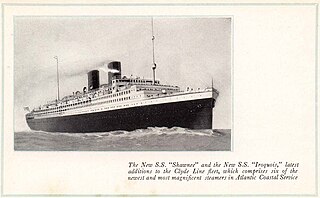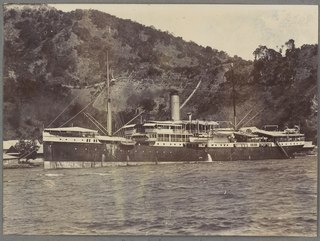
MS Wanganella was an Australian-registered ocean liner built by Harland and Wolff that entered service on the trans-Tasman route in 1933. Originally named Achimota, she was acquired by Huddart Parker after the original sale to Elder Dempster Lines fell through.

South West Pacific Area (SWPA) was the name given to the Allied supreme military command in the South West Pacific Theatre of World War II. It was one of four major Allied commands in the Pacific War. SWPA included the Philippines, Borneo, the Dutch East Indies, East Timor, Australia, the Territories of Papua and New Guinea, and the western part of the Solomon Islands. It primarily consisted of United States and Australian forces, although Dutch, Filipino, British and other Allied forces also served in the SWPA.

Australian Hospital Ship (AHS) Centaur was a hospital ship which was attacked and sunk by a Japanese submarine off the coast of Queensland, Australia, on 14 May 1943. Of the 332 medical personnel and civilian crew aboard, 268 died, including 63 of the 65 army personnel.

Koninklijke Paketvaart-Maatschappij, better known as KPM, was a Dutch shipping company (1888–1966) in the Netherlands East Indies, now Indonesia. It was the dominant inter-island shipping line in Indonesia during the last half century of the colonial era.

TSMV Manunda was an Australian registered and crewed passenger ship which was converted to a hospital ship in 1940. During the war Manunda saw service in both the Middle East and Pacific Campaigns, specifically New Guinea. She resumed her passenger duties after the war, before being sold to a Japanese company and finally broken up in 1957.

SS 's Jacob Dutch freighter built by Maatschappij Fijenoord, Rotterdam, Netherlands, in 1907, of 2,839 GRT and operated by Koninklijke Paketvaart-Maatschappij (KPM) in the Dutch East Indies trade. The ship, after seeking refuge in Australia during the Japanese invasion of the islands, became part of the Southwest Pacific Area (SWPA) command's permanent local fleet. 's Jacob was sunk off Papua New Guinea on 8 March 1943 during World War II by Japanese air attack.

SS Bantam was built by N.V. Machinefabriek & Scheepswerf van P. Smit Jr. of Rotterdam, Netherlands in 1930 of 3322 gross weight and operated by Koninklijke Paketvaart-Maatschappij. Bantam, under charter, became a part of the initial United States Army local fleet in Australia, was severely damaged 28 March 1943 in New Guinea and eventually scuttled off Sydney.

Operation Lilliput was the name given to a convoy operation directed by G.H.Q. Operations Instructions Number 21 of 20 October 1942 for transportation of troops, weapons, and supplies in a regular transport service between Milne Bay and Oro Bay, New Guinea between 18 December 1942 and June 1943 in order "to cover reinforcement, supply, and development of the Buna-Gona area upon its anticipated capture" by the Australian 7th Division and the United States Army's 32d Division. Within six months, the convoys, escorted by Royal Australian Navy corvettes and largely composed of Dutch KPM merchant ships, had delivered 60,000 tons of supplies and 3,802 troops from Milne Bay to Oro Bay. Corvettes provided the majority of the escort force. Losses during Imperial Japanese air attacks amounted to two merchant ships, 's Jacob and Van Heemskerk, sunk and two badly damaged while several of the corvettes also sustained damage and casualties.

Booya was a three-masted schooner with a steel hull built in the Netherlands in 1917. She was originally named De Lauwers. The schooner was renamed Argosy Lemal in 1920 and carried that name until 1949. As Argosy Lemal the ship served as one of the early United States Army communications ships from 1942–1949. In 1949, on return to civilian use, the vessel was renamed Ametco, Clair Crouch and finally Booya in 1964. Booya was last seen anchored off Fort Hill wharf in Darwin Harbour at about 8.00pm on 24 December 1974, the evening Cyclone Tracy hit Darwin. Nearly twenty-nine years later, in October 2003, she was discovered by chance in Darwin Harbour, lying on her starboard side in about 20 metres of water.

SS Tasman was a 4,922 gross register tons (GRT) Dutch steamship built by Earle's Shipbuilding and Engineering Company Limited, Hull in 1921 for Koninklijke Paketvaart-Maatschappij (KPM), Batavia. With outbreak of the war in the Pacific and the fall of the Dutch East Indies, Tasman was one of 21 KPM vessels that sought refuge in Australia. These ships became the core of the initial Southwest Pacific Area (SWPA) command's permanent local fleet under U.S. Army control. After general service as a transport, the ship was converted to a hospital ship at Melbourne. The ship, under the Dutch flag and Dutch certification under the Hague Convention, served the remainder of the war as a Dutch hospital ship.

The paddle steamer PS Weeroona was built by A. & J. Inglis, Pointhouse, Glasgow, Scotland and launched in 1910. It was initially owned by Huddart Parker Ltd, Melbourne. The ship was requisitioned for wartime service and used by the United States Army as a barracks and quarters ship through the war.

Shawnee was a passenger steam turbine-powered ship built in 1926-1927 by Newport News Ship Building & Drydock Co. of Newport News for Clyde Steamship Company, a subsidiary of Atlantic, Gulf & West Indies Steamship Lines with intention of operating between New York and southern ports of the United States. During the World War II the liner was requisitioned by the US Government, and served as the United States Army Transport from September 1942 to March 1946 in the Atlantic, Mediterranean and Pacific. Following the end of the war, the ship was sold to a Portuguese company and renamed City of Lisbon, and subsequently resold to Yugoslavia, becoming Partizanka operating with the shipping company Jugoslavenska Linijska Plovidba until 1949 when the steamer burned while in drydock and was declared a total loss.

MS Sea Witch was a United States Maritime Commission type C2 cargo ship, the first of four pre-war hulls, built by Tampa Shipbuilding & Engineering Company, Tampa, Florida and delivered in July 1940. The ship was of the basic C2 design, rather than the more numerous C2-S, C2-S-A1, C2-S-B1 types and four C2-T hulls delivered December 1941 through March 1942. Sea Witch was one of the relatively few C2 types built with diesel engines.

Registan, built 1910, was the first name for a ship serving fifty years under the later names Guantanamo, USS Guantanamo (ID-1637), Comerio, Vittorin, Grey Lag and finally Hai Lung until scrapping in 1960. The ship transported gunpowder and munitions during World War I as USS Guantanamo and as a cargo ship during World War II for the War Shipping Administration (WSA). After 12 October 1943 the ship was assigned to the Southwest Pacific Area command's permanent local fleet as the United States Army transport Grey Lag with that fleet's number X-101. In April 1945 she was one of the transports towing large barges from Australia and New Guinea to the Philippines after that concept to mitigate shipping shortages had been proven feasible. In 1946 the ship was sold to the Republic of China and renamed Hai Lung.

SS Karsik was a German-built cargo steamship. Deutsche Schiff- und Maschinenbau (Deschimag) built her as Soneck for Deutsche Dampfschifffahrts-Gesellschaft "Hansa" in 1938.

SS Japara was a freighter of 3,323 GRT built by Mach. Fabr. & Scheepswerf P. Smit Jr., Rotterdam in 1930 and operated by Koninklijke Paketvaart-Maatschappij (KPM) in the Dutch East Indies trade. The 1930 Japara was operating with the United States Army permanent local fleet of the U.S. Army Forces in Australia (USAFIA) from 1942 until 1945 even while the larger ship, 9,312 GRT MS Japara (1938), was active in Army service oceanwide. Japara of 1930 played an important logistics role in the New Guinea Campaign.
A number of ships have carried the name Japara:

SS Van Heemskerk was a freighter built by N.V. Nederlandsche Scheepsbouw-Maatschappij with engines built by Nederlandsche Fabriek van Werktuigen & Spoorwegmaterieel N.V, both of Amsterdam, Netherlands. The ship of 2,996 GRT was launched 31 August 1909 and delivered 29 October 1909 for operation by Koninklijke Paketvaart-Maatschappij (KPM) in the Dutch East Indies trade.

MS Maetsuycker was a Dutch cargo ship and later converted to a hospital ship. She was named after Joan Maetsuycker.

MS Van Heutsz was a Dutch diesel powered passenger and cargo vessel of the Koninklijke Paketvaart-Maatschappij (KPM) line operating from Batavia in the Dutch East Indies. The ship, as was sister ship Cremer, was designed for the longer routes of the East Indies inter-island trade extending to Singapore and Hong Kong. The ships had limited cabin accommodation for passengers but large deck passenger capacity. Much of the passenger trade was with Chinese moving between China, Singapore and the East Indies.




















